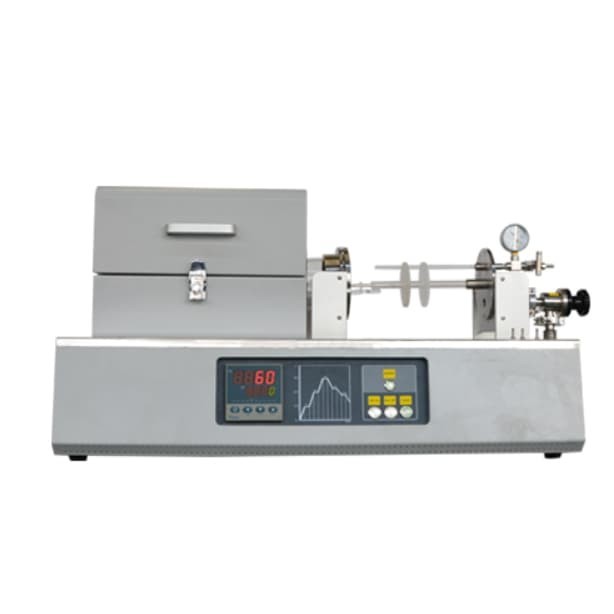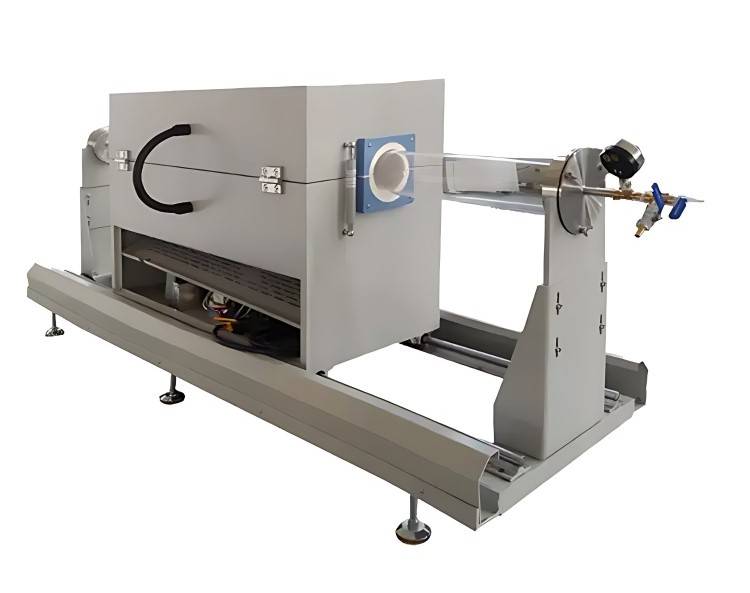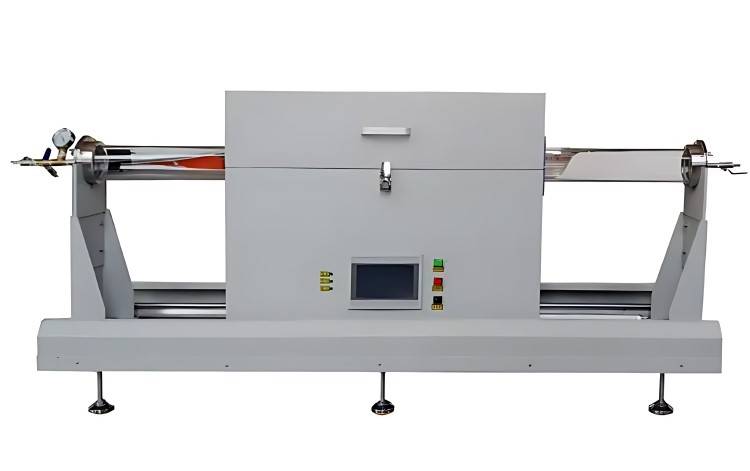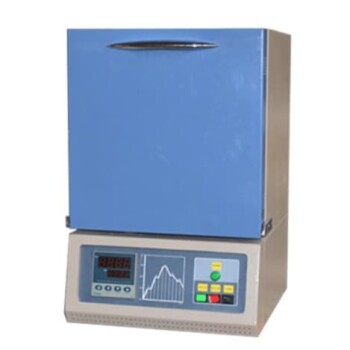
Tube Furnace
Laboratory Quartz Tube Furnace RTP Heating Tubular Furnace
Item Number : KT-RTP
Price varies based on specs and customizations
- Max. temperature
- 1100℃
- Heating zone length
- 300~800 mm
- Temperature control accuracy
- ±1℃
Shipping:
Contact us to get shipping details Enjoy On-time Dispatch Guarantee.
Why Choose Us
Reliable PartnerEasy ordering process, quality products, and dedicated support for your business success.
RTP Rapid Heating Tube Furnace: Visual Overview and Core Components
KINTEK's RTP Rapid Heating Tube Furnace is engineered for applications demanding rapid temperature changes and precise control. It is widely used for processes such as large-scale graphene growth via CVD, temperature sensor calibration, material testing, and various heat treatments. This furnace allows for operation in controlled atmosphere environments or high vacuum, creating an ideal thermal processing chamber.




1. Temperature control table features: 30 programmable automatic control segments; includes ultra-temperature and broken thermocouple protection.
2. High-quality hearth materials: Utilizes imported polycrystalline ceramic fiber, ensuring no powder shedding, excellent insulation, high reflectivity, balanced temperature field, resistance to thermal expansion/contraction, large capacity, and multi-functional sintering capabilities.
3.High-end heating element: Features high-purity heating elements and fiber hearth for internal cleanliness.
Key Capabilities for Advanced Thermal Processing
Our RTP Rapid Heating Tube Furnace offers exceptional performance tailored to demanding research and production environments:
- Unmatched Heating & Cooling Speeds: Achieve your target high temperature in minimal time with heating speeds up to 100°C per second (e.g., reaching 1000°C in approximately one minute). Experience equally impressive cooling speeds up to 110°C per second. Rapid cooling is achieved by efficiently sliding the furnace tube out of the heating and insulation chamber, a process further accelerated by controlled fast circulating air in an open-air environment.
- Precision Temperature Management: A strategically placed temperature sensor, in direct contact with sample holders, ensures highly accurate temperature control and reliable indication. The system features PID programmable temperature control for excellent control accuracy and stable heating performance, with support for remote and centralized control.
- Versatile Atmosphere Control: Configure the furnace with various vacuum pump station setups to operate under a controlled atmosphere or a high vacuum environment, creating the ideal thermal processing chamber for your specific needs.
- User-Centric and Robust Design:
- A convenient sliding rail system holds the furnace tube flange, making it easy to withdraw the tube from the furnace heating insulation chamber.
- The double furnace shell design, with forced airflow between the inner and outer shells, maintains a low furnace surface temperature for enhanced operator safety and comfort.
- The RTP Pro model includes a 7-inch TFT touch screen controller, offering a more user-friendly interface for program setting, history data analysis, and the ability to save and select different program recipes.
Why Choose KINTEK's RTP Furnace?
Leveraging exceptional R&D and in-house manufacturing, KINTEK provides diverse laboratories with advanced high-temperature furnace solutions. The RTP Rapid Heating Tube Furnace embodies this commitment by offering:
- Accelerated Throughput: Dramatically reduce your processing times with industry-leading heating and cooling rates.
- Reliable and Repeatable Results: Ensure the consistency of your experiments and production with precise temperature control and high-quality components.
- Operational Efficiency: User-friendly features and a robust design minimize setup time and maintenance requirements.
- Tailored to Your Needs: Beyond the comprehensive features of this RTP furnace, KINTEK excels with strong deep customization capabilities to precisely meet unique experimental requirements. Our extensive product line also includes Muffle Furnaces, standard Tube Furnaces, Rotary Furnaces, Vacuum & Atmosphere Furnaces, and specialized CVD/PECVD/MPCVD Systems.
Ready to elevate your thermal processing capabilities? Contact our specialists today to discuss your specific application, explore customization options, or request a personalized quote. We are dedicated to helping you find the perfect furnace solution.
Applications
RTP rapid heating tube furnaces are designed for fast heating and cooling applications. They are widely used in the following areas:
- Graphene growth:RTP furnaces are used to heat graphene precursors to high temperatures in a controlled atmosphere, promoting graphene growth.
- Temperature sensor calibration: RTP furnaces can be used to calibrate temperature sensors by exposing them to precisely controlled temperatures.
- Material testing: RTP furnaces can be used to test the thermal properties of materials, such as their melting point and thermal conductivity.
- Heat treatment: RTP furnaces can be used to heat treat materials to improve their properties, such as their strength and hardness.
- Annealing: RTP furnaces can be used to anneal materials, which involves heating them to a high temperature and then slowly cooling them to relieve stress and improve their ductility.
- Brazing: RTP furnaces can be used to braze materials together, which involves heating them to a high temperature and melting a filler metal to join them.
- Calcining: RTP furnaces can be used to calcine materials, which involves heating them to a high temperature to drive off volatile components.
- Ceramics: RTP furnaces can be used to fire ceramics, which involves heating them to a high temperature to harden and strengthen them.
- Cleaning: RTP furnaces can be used to clean materials by heating them to a high temperature to remove contaminants.
- Crystal growth: RTP furnaces can be used to grow crystals by heating a material to a high temperature and then slowly cooling it, allowing crystals to form.
- Firing: RTP furnaces can be used to fire materials, which involves heating them to a high temperature to harden and strengthen them.
- Glass: RTP furnaces can be used to melt and anneal glass, which involves heating it to a high temperature and then slowly cooling it to relieve stress and improve its strength.
- Gradient work: RTP furnaces can be used to create temperature gradients, which can be used to study the effects of temperature on materials.
- Heat treating: RTP furnaces can be used to heat treat materials to improve their properties, such as their strength and hardness.
- Laboratory research: RTP furnaces are used in a variety of laboratory research applications, such as materials science, chemistry, and physics.
- Materials testing: RTP furnaces are used to test the thermal properties of materials, such as their melting point and thermal conductivity.
- Melting: RTP furnaces can be used to melt materials, such as metals and plastics.
- Powders: RTP furnaces can be used to heat and cool powders, which can be used to create new materials or modify the properties of existing materials.
Technical Specifications
| Furnace model | KT-RTP | KT-RTP Pro |
| Temperature controller | Digital PID controller | Touch screen PID controller |
| Multi program preset | no | yes |
| Power failure restarting | no | yes |
| Max. temperature | 1100℃ | |
| Constant work temperature | 1000℃ | |
| Furnace tube material | High grade Quartz/ Al2O3 alumina | |
| Furnace tube diameter | 50 / 60 / 80 / 100 mm | |
| Heating zone length | 300 / 450 / 600 / 800 mm | |
| Vacuum sealing solution | SS 304 flange with solid copper seal ring | |
| Rated vacuum pressure | 0.001Pa/10E5 torr | |
| Chamber material | Japan Al2O3 alumina fiber | |
| Heating element | Cr2Al2Mo2 wire coil | |
| Temperature sensor | Build in K type Thermal couple | |
| Temperature control accuracy | ±1℃ | |
| Electric power supply | AC110-220V,50/60HZ | |
| Other furnace tube size and heating zone length can be customized | ||
Advanced Safety Features
- Kindle Tech tube furnace owns over current protection and over temperature alarming function, furnace will turn off the power automatically once over current detected
- Furnace build in thermal couple detecting function, furnace will stop heating and alarm will be on once thermal couple broken or failure detected
- RTP Pro support power failure restarting function,furnace will resume the furnace heating program when power is incoming after failure
Standard Package & Customization Options
Standard Package
| No. | Description | Quantity |
| 1 | Furnace | 1 |
| 2 | Alumina tube | 1 |
| 3 | Vacuum flange | 2 |
| 4 | Tube thermal block | 2 |
| 5 | Tube thermal block hook | 1 |
| 6 | Heat resistant glove | 1 |
| 7 | Operation manual | 1 |
Optional Setup
- In tube gases detecting and monitoring,like H2, O2 and so on
- Independent furnace temperature monitoring and recording
- RS 485 communication port for PC remote control and data exporting
- Insert gases feeding flow rate control,like mass flowmeter and float flowmeter
- Touch screen temperature controller with versatile operator friendly functions
- High vacuum pump station setups, like vane vacuum pump,molecular pump,diffusion pump
Further customize your RTP furnace to meet specific experimental needs. Discuss your requirements with our experts for a tailored configuration and ensure your KINTEK furnace perfectly aligns with your research or production goals.
FAQ
What Is A Tube Furnace And How Does It Work?
What Is A Vertical Tube Furnace?
What Are The Main Applications Of A Rotary Tube Furnace?
What Are The Main Applications Of Multi-zone Tube Furnaces?
What Is The Principle Of A Hot Press Furnace?
What Are The Common Applications Of A Split Tube Furnace?
What Is The Principle Of A Rotary Furnace?
What Is A Dental Furnace Used For?
What Are The Main Applications Of Tube Furnaces?
What Are The Applications Of A Vertical Tube Furnace?
What Are The Key Features Of A Rotary Tube Furnace?
What Are The Key Features Of Multi-zone Tube Furnaces?
What Are The Applications Of A Hot Press Furnace?
What Are The Key Features Of A Split Tube Furnace?
What Are The Advantages Of Using A Rotary Furnace?
What Are The Key Features Of A Dental Furnace?
What Are The Advantages Of Using A Tube Furnace?
What Are The Advantages Of A Vertical Tube Furnace?
How Does A Rotary Tube Furnace Work?
How Does A Multi-zone Tube Furnace Work?
What Are The Features Of A Hot Press Furnace?
How Does A Split Tube Furnace Work?
What Are The Key Features Of A Rotary Furnace?
How Does A Dental Furnace Work?
What Types Of Tube Furnaces Are Available?
How Does A Vertical Tube Furnace Work?
What Are The Advantages Of Using A Rotary Tube Furnace?
What Are The Advantages Of Using A Multi-zone Tube Furnace?
Why Is A Vacuum Environment Used In Hot Press Furnaces?
What Are The Advantages Of Using A Split Tube Furnace?
What Are The Common Applications Of A Rotary Furnace?
What Are The Advantages Of Using A Dental Furnace?
What Temperature Ranges Can Tube Furnaces Achieve?
What Types Of Vertical Tube Furnaces Are Available?
What Temperature Can A Rotary Tube Furnace Reach?
What Types Of Multi-zone Tube Furnaces Are Available?
What Materials Are Commonly Processed In Hot Press Furnaces?
What Temperature Can A Split Tube Furnace Reach?
How Does A Rotary Furnace Handle Different Materials?
What Safety Features Should A Dental Furnace Have?
Can Tube Furnaces Operate Under Different Atmospheres?
Why Choose A Vertical Tube Furnace Over A Horizontal One?
What Types Of Materials Can Be Processed In A Rotary Tube Furnace?
Why Is The Split Design Beneficial In A Tube Furnace?
What Types Of Dental Furnaces Are Available?
What Makes KINTEK Tube Furnaces Special?
What Temperature Ranges Can Vertical Tube Furnaces Achieve?
Are Vertical Tube Furnaces Customizable?
4.9
out of
5
Incredibly fast delivery! The furnace works like a charm—perfect for our lab needs.
4.8
out of
5
Top-notch quality and durability. Worth every penny for serious researchers.
4.7
out of
5
The technological advancement in this furnace is impressive. Highly recommend!
4.9
out of
5
Precision heating and robust build. A game-changer for our experiments.
4.8
out of
5
Superb value for money. Delivered faster than expected—very satisfied!
4.7
out of
5
Reliable and efficient. Perfect for high-temperature applications.
4.9
out of
5
Exceptional quality and performance. Exceeded all our expectations.
4.8
out of
5
Fast shipping and easy setup. The furnace is a beast in the lab!
4.7
out of
5
Durable and precise. A must-have for any serious laboratory.
4.9
out of
5
Cutting-edge technology with flawless performance. Highly impressed!
4.8
out of
5
Great investment for our research. The quality is unmatched.
4.7
out of
5
Speedy delivery and outstanding product. Perfect for our needs.
4.9
out of
5
The furnace is a powerhouse! Delivered quickly and works flawlessly.
4.8
out of
5
Excellent value and performance. A reliable tool for any lab.
4.7
out of
5
High-quality build and precise heating. Very happy with this purchase.
4.9
out of
5
Fast, efficient, and durable. Exactly what our lab needed.
4.8
out of
5
Superior technology and robust design. A fantastic addition to our lab.
4.7
out of
5
Quick delivery and excellent performance. Highly recommended!
4.9
out of
5
The furnace is a marvel—fast, precise, and built to last. Love it!
REQUEST A QUOTE
Our professional team will reply to you within one business day. Please feel free to contact us!
Related Products

High Pressure Laboratory Vacuum Tube Furnace Quartz Tubular Furnace
KINTEK High Pressure Tube Furnace: Precision heating up to 1100°C with 15Mpa pressure control. Ideal for sintering, crystal growth, and lab research. Customizable solutions available.

Vertical Laboratory Quartz Tube Furnace Tubular Furnace
Precision KINTEK Vertical Tube Furnace: 1800℃ heating, PID control, customizable for labs. Ideal for CVD, crystal growth & materials testing.

1200℃ Split Tube Furnace Laboratory Quartz Tube Furnace with Quartz Tube
Discover KINTEK's 1200℃ Split Tube Furnace with quartz tube for precise high-temperature lab applications. Customizable, durable, and efficient. Get yours now!

1400℃ High Temperature Laboratory Tube Furnace with Quartz and Alumina Tube
KINTEK's Tube Furnace with Alumina Tube: Precision high-temperature processing up to 2000°C for labs. Ideal for material synthesis, CVD, and sintering. Customizable options available.

1700℃ High Temperature Laboratory Tube Furnace with Quartz or Alumina Tube
KINTEK's Tube Furnace with Alumina Tube: Precision heating up to 1700°C for material synthesis, CVD, and sintering. Compact, customizable, and vacuum-ready. Explore now!

Laboratory Vacuum Tilt Rotary Tube Furnace Rotating Tube Furnace
KINTEK Laboratory Rotary Furnace: Precision heating for calcination, drying, sintering. Customizable solutions with vacuum & controlled atmosphere. Enhance research now!

Split Multi Heating Zone Rotary Tube Furnace Rotating Tube Furnace
Precision Split Multi Heating Zone Rotary Tube Furnace for high-temperature material processing, featuring adjustable tilt, 360° rotation, and customizable heating zones. Ideal for labs.

Multi Zone Laboratory Quartz Tube Furnace Tubular Furnace
KINTEK Multi-Zone Tube Furnace: Precise 1700℃ heating with 1-10 zones for advanced material research. Customizable, vacuum-ready, and safety-certified.

High Temperature Muffle Oven Furnace for Laboratory Debinding and Pre Sintering
KT-MD Debinding & Pre-Sintering Furnace for ceramics - precise temperature control, energy-efficient design, customizable sizes. Boost your lab efficiency today!

Split Chamber CVD Tube Furnace with Vacuum Station CVD Machine
Split Chamber CVD Tube Furnace with Vacuum Station - High precision 1200°C lab furnace for advanced materials research. Customizable solutions available.

Multi Heating Zones CVD Tube Furnace Machine for Chemical Vapor Deposition Equipment
KINTEK's Multi-Zone CVD Tube Furnaces offer precision temperature control for advanced thin film deposition. Ideal for research and production, customizable for your lab needs.

Custom Made Versatile CVD Tube Furnace Chemical Vapor Deposition CVD Equipment Machine
KINTEK's CVD Tube Furnace offers precision temperature control up to 1600°C, ideal for thin film deposition. Customizable for research and industrial needs.

Slide PECVD Tube Furnace with Liquid Gasifier PECVD Machine
KINTEK Slide PECVD Tube Furnace: Precision thin film deposition with RF plasma, rapid thermal cycling, and customizable gas control. Ideal for semiconductors and solar cells.

Inclined Rotary Plasma Enhanced Chemical Deposition PECVD Tube Furnace Machine
KINTEK's PECVD coating machine delivers precision thin films at low temperatures for LEDs, solar cells & MEMS. Customizable, high-performance solutions.

Electric Rotary Kiln Small Rotary Furnace Biomass Pyrolysis Plant Rotating Furnace
KINTEK's Rotary Biomass Pyrolysis Furnace converts biomass to biochar, bio-oil, and syngas efficiently. Customizable for research or production. Get your solution now!

Vacuum Sealed Continuous Working Rotary Tube Furnace Rotating Tube Furnace
Precision rotary tube furnace for continuous vacuum processing. Ideal for calcination, sintering, and heat treatment. Customizable up to 1600℃.

Vacuum Hot Press Furnace Machine Heated Vacuum Press Tube Furnace
Discover KINTEK's advanced Vacuum Tube Hot Press Furnace for precise high-temperature sintering, hot pressing, and material bonding. Customizable solutions for labs.

Vacuum Induction Melting Furnace and Arc Melting Furnace
Explore KINTEK's Vacuum Induction Melting Furnace for high-purity metal processing up to 2000℃. Customizable solutions for aerospace, alloys, and more. Contact us today!

1200℃ Muffle Oven Furnace for Laboratory
KINTEK KT-12M Muffle Furnace: Precision 1200°C heating with PID control. Ideal for labs needing rapid, uniform heat. Explore models & customization options.
Related Articles

The Hidden Cause of Uneven Heating in Your Furnace (And How to Fix It)
Struggling with inconsistent heating, warped samples, and failed furnace runs? Discover the hidden cause—and how a correctly engineered system can deliver reliable results.

Your Furnace Isn't Just a Heater: Why 'Good Enough' Equipment Is Sabotaging Your Advanced Materials Research
Struggling with inconsistent results from your tube furnace? Discover why standard equipment fails and how a modular, customizable approach is key to success.

Why Your Tube Furnace Is Failing Your Experiments (And It’s Not the Temperature)
Discover the hidden reason your high-temperature experiments fail. It's not your process; it's a material mismatch inside your furnace. Learn how to fix it.

Why Your Crystal Growth Experiments Are Failing: The Hidden Culprit in Your Tube Furnace
Struggling with inconsistent CVT results? Discover why your tube furnace's temperature gradient, not your chemistry, is the likely culprit and how to fix it.

Beyond Temperature: Why Your Material Processing Fails and How to Fix It
Frustrated by inconsistent material processing? Discover the real reason your results fail and how a furnace designed for synergy is the key to control.

Your Lab Furnace Is Burning Money. Here's the Hidden Design Flaw (And How to Fix It).
Discover the hidden design flaw making your lab furnace inefficient and costly. Learn how a system-level approach to design can cut energy waste.

Why Your High-Temperature Furnace Fails: The Hidden Culprit Beyond the Cracked Tube
Frustrated by failed high-temp experiments? Learn why replacing parts doesn't work and how a system-engineered furnace ensures reliable, repeatable results.

Why Your High-Temperature Experiments Fail: It’s Not Bad Luck, It’s Your Furnace
Are inconsistent results from your high-temperature furnace derailing your research? Discover the hidden design flaws that cause failures and how to fix them for good.

Your Process is Perfect. Why Are Your Furnace Results Failing?
Discover the hidden reason your high-temperature furnace delivers inconsistent results and why "standard" features aren't enough for advanced applications.

The Invisible Saboteur: Why Your High-Temp Furnace Fails (And How to Stop It)
Frustrated by recurring furnace failures and short circuits? Discover the hidden cause—metallic vapor deposition—and learn how a furnace truly designed for your process can end the cycle for good.

Beyond the Alarm: The Hidden Safety Risks in Your High-Temperature Furnace
Discover the crucial difference between a simple safety feature and a true safety system in lab furnaces. Learn how to mitigate hidden risks to protect your people, materials, and investment.

Why Your High-Temperature Furnace Delivers Inconsistent Results—And How Geometry Is the Key to Fixing It
Struggling with uneven heating and failed batches in your furnace? Discover the root cause isn't what you think and how to achieve perfect thermal uniformity.